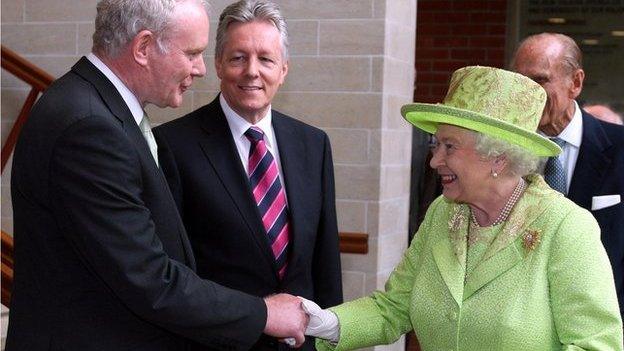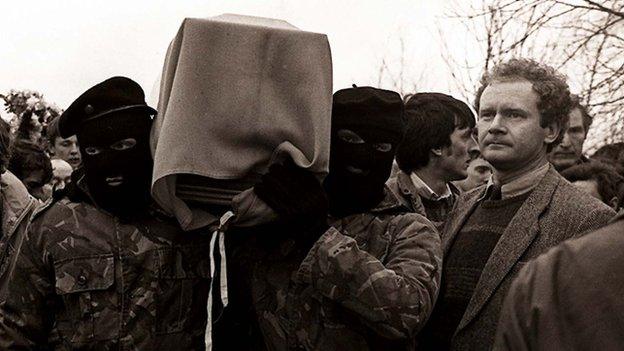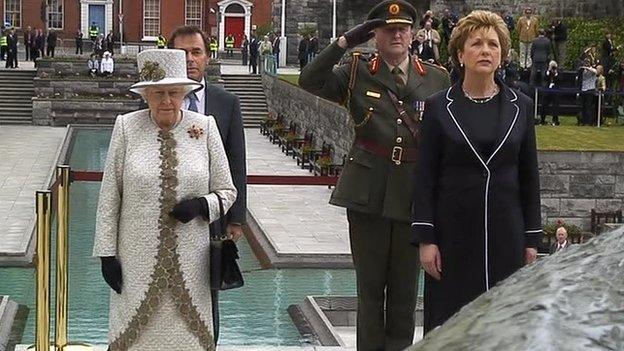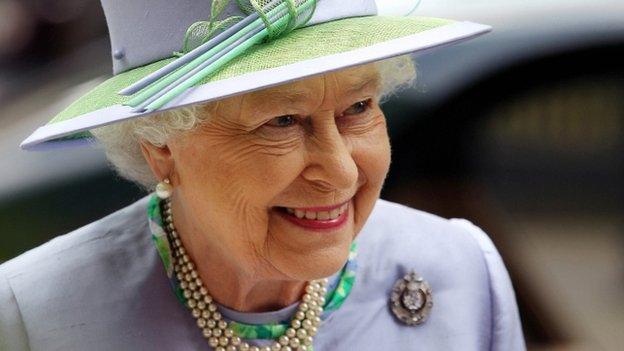Timeline: Martin McGuinness and the Queen
- Published

Sinn Féin's Martin McGuinness met the Queen for the first time in June 2012
The Queen is hosting the first ever UK state visit by an Irish president, as Michael D Higgins begins a four-day diplomatic mission to Great Britain.
However, much of the attention will fall on Sinn Féin's Martin McGuinness, who recently tried and failed to win the role currently held by Mr Higgins.
Mr McGuinness, a former IRA man and life-long republican, will be among the monarch's guests at Windsor Castle.
He met the Queen in 2012, but the visit still holds challenges for Sinn Féin.
The UK state visit marks another significant milestone in Anglo-Irish relations and further fascination for those who have followed Mr McGuinness' long journey from paramilitary to politician to palace guest.
BBC News looks back at the significant events and political choreography affecting Sinn Féin's relationship with royalty.
1969
The government deploys the Army to Northern Ireland following widespread civil unrest and violent sectarian clashes between Catholics and Protestants. The deployment, known as Operation Banner, was to become the longest continuous campaign in the Army's history.
1970
Martin McGuinness, aged about 20, joins the Irish Republican Army (IRA) and quickly becomes an influential figure within the paramilitary organisation in his native Derry. Interviewed by the BBC during a walkabout in the city, a baby-faced McGuinness does not correct the correspondent when he described him as the "Officer Commanding for the Derry part of the IRA Provisional operation".
1973
Martin McGuinness is sentenced to six months in prison by the Republic of Ireland's Special Criminal Court, after he was caught in a car containing large quantities of explosives and ammunition.
He tells the court he is "very proud" of his IRA membership.

Martin McGuinness pictured with masked men at an IRA funeral in 1988
27 August 1979
The Queen's cousin, Lord Louis Mountbatten, is killed by an IRA bomb while on holiday in County Sligo in the Republic of Ireland. Two of his relations and a 15-year old local boy are also killed in the explosion.
Hours later, 18 soldiers are killed in a double IRA bombing at Warrenpoint, County Down. It is the highest death toll suffered by the Army in a single incident in Northern Ireland.
1 May 1997
Martin McGuinness is elected to the British House of Commons as a MP for Mid Ulster. Adhering to Sinn Féin's long-standing policy of abstentionism, he refuses to take his seat or swear an oath of allegiance to the Queen.
10 April 1998
The Good Friday Agreement is signed in Belfast following years of intensive peace talks between political parties in Northern Ireland and the British and Irish governments.
Martin McGuiness was Sinn Féin's chief negotiator during the deliberations. The accord paves the way for devolution through a new power-sharing coalition of unionists and nationalists at Stormont.
29 November 1999
Martin McGuinness, who left school at the age of 15 without any formal qualifications, is appointed as education minister at the Northern Ireland Assembly.
28 July 2005
The IRA releases a statement saying it has "formally ordered an end to the armed campaign". The paramilitary organisation, believed to be responsible for more than 1,700 deaths over a 35-year period, says it it now committed to "exclusively peaceful means".
8 May 2007
Martin McGuinness becomes deputy first minister of Northern Ireland after an election that followed a power-sharing agreement between Sinn Féin and the Democratic Unionist Party. He forms an unlikely political relationship with his former foe Ian Paisley, and the pair are quickly nicknamed the Chuckle Brothers.
17 May 2011
The Queen begins a four-day state visit to the Republic of Ireland, travelling to Dublin, Cork and County Tipperary. It is the first official visit by a British monarch since the foundation of the state. In an itinerary rich in symbolism, the Queen lays a wreath in tribute to Irish rebels who died fighting for independence.

The Queen and former Irish President Mary McAleese paid tribute to Irishmen who died fighting for independence from British rule during the monarch's first state visit to the Republic of Ireland in 2011
She also speaks a few words in the Irish language during her keynote speech at Dublin Castle, once the home of British rule in Ireland.
The trip is hailed as a diplomatic success and a "game changer" for Anglo-Irish relations. Sinn Féin refuses to meet the Queen during the visit, and Martin McGuinness declines an invitation to the Dublin Castle event, but their stance is viewed by many commentators as out of step with the overwhelming mood of the Irish people.
17 September 2011
Martin McGuinness announces he wants to become the next Irish president and formally enters the election campaign. He says if he wins the vote, he is prepared to meet all heads of state without exception, including the Queen.
22 January 2012
Martin McGuinness tells the BBC that that Queen's visit to the Republic of Ireland had "made an impact" on him. He commends her use of the Irish language and that she was "prepared to stand in a very dignified way to honour those patriots who struggled in 1916 to bring about a free and independent 32-county Irish Republic".
11 June 2012
Minister Martin McGuinness says it would be "huge ask" on the part of any Irish republican to meet the Queen. He criticises the Northern Ireland Office for announcing plans for a Queen's Jubilee party at Stormont at the end of the month, without consulting Sinn Féin. He describes the NIO's conduct as "insensitive".
22 June 2012
Sinn Féin agrees to a historic first meeting with the Queen following a special meeting of the party. Martin McGuinness will not attend the Jubilee party but instead will meet the Queen and shake her hand at a charity reception in Belfast within days.
27 June 2012
The Queen and Martin McGuinness meet for the first time and shake hands in public and in private at a charity event in Belfast's Lyric Theatre.
The Queen shook hands with former IRA commander Martin McGuinness.
The historic handshake between a British monarch and a former paramilitary turned politician is hailed as a significant moment in the Irish peace process.
Mr McGuinness greets the Queen in the Irish language and tells her that their meeting was a "powerful signal that peace-building requires leadership".
29 June 2012
Martin McGuinness tells BBC Radio Four's Today programme he shook hands with the Queen "to extend a hand of friendship, peace and reconciliation" to unionists in the region. When asked by presenter John Humphrys why he was referring to Her Majesty as the Queen and no longer as Mrs Windsor, he explained that "when people are gracious and step up to the plate we have to reciprocate".
11 October 2013
Martin McGuinness raises a few laughs - and perhaps just as many eyebrows - as he reveals he once slept in the Queen's bed at Hillsborough Castle, the official royal residence in Northern Ireland.
McGuinness reveals he had slept in the Queen's bed at Hillsborough Castle
In an after dinner speech, he tells a business conference that Sinn Féin was assigned the Queen's bedroom during days of devolution negotiations at the castle in 2010.
"I do not want you to tell anybody," he tells his chuckling audience, "but I had a snooze in her bed. She was not in it, so no scandal attached."
5 April 2014
Sinn Féin announces Martin McGuinness will attend a banquet hosted by the Queen during next week's state visit to Britain by Irish President Michael D Higgins. Party president Gerry Adams says the decision had to be viewed against the backdrop of huge political change in recent years.
6 April 2014
Martin McGuinness praises the Queen for her "leadership role" in the Irish peace process. He says she is a "staunch supporter" of the Irish peace process and impressed him with her words and deeds during her highly symbolic state visit to the Republic of Ireland in May 2011.
- Published6 April 2014
.jpg)
- Published22 June 2012

- Published11 June 2012
